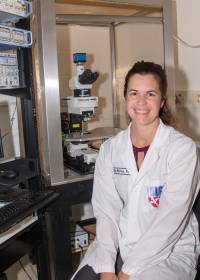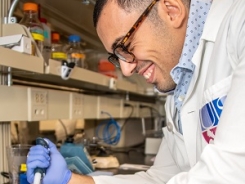Petrus Lab
We study how the adult brain reacts to injury such as denervation or amputation. Some amputees experience beneficial adaptations during recovery, for example learning to use a prosthetic or increasing functional accuracy with the intact limb. Other amputees suffer from phantom limb pain or hyperalgesia, which impairs their ability to recover and negatively impacts their quality of life. The goal of our research is to identify the specific neurons that drive the brain’s adaptations to injury and modulate their activity to improve behavioral recovery or ameliorate chronic pain conditions. We use a mouse model where the whisker nerves are cut, effectively amputating whiskers on one side of the face. When mice are imaged with functional magnetic resonance imaging (fMRI) their brain activity patterns mimic those observed in human amputees. Using an animal model allows us to discover the neurons, synapses and circuits that underlie behavioral adaptations after injury. A more complete understanding of the cellular events that occur after denervation will allow us to determine which mechanisms are aligned with beneficial or maladaptive behavioral outcomes. Treatments of the future could use this knowledge to modulate brain activity to produce better outcomes for amputees.
Experimental Approaches
We seek to characterize the neuronal adaptations that underlie the altered fMRI and behavioral changes with a combination of experimental techniques.
- Molecular neuroscience techniques detect gene and protein expression that are altered in specific groups of brain cells after injury. Single nucleus RNAsequencing, in situ hybridization (RNAscope HiPlex) and immunohistochemistry are used to detect the molecular identity of brain cells and the adaptations they undergo after injury.
- Whole cell patch clamp electrophysiology (plus optogenetics!) detects how neurons behave and communicate with each other within a circuit. After injury, neurons can alter these parameters to recalibrate the neural circuit. These recalibrations have been hypothesized to underlie both beneficial learning and maladaptive consequences, thus more recordings are necessary to deduce which cells and circuits may be involved in either adaptation type after injury.
- Mouse behavior gives important clues into how the animal experiences life after injury. We use a combination of observational and learning behaviors to detect if whisker denervation affects mouse behavior. Pain, anxiety and depression often occur after injury, thus we look for behaviors in mice that correlate with these clinical signs.
Lab Culture
|
|






